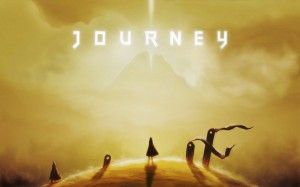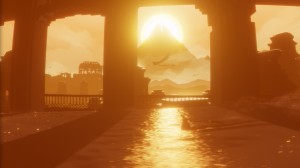Journey is the latest game by Thatgamecompany and director Jenova Chen (best known for Flower). The story is very simple: you play an unnamed wanderer heading towards a mountain in the distance. While traversing deserts, caves, and mountains, you pass through the ruins of a once great civilization. Eventually, you uncover what happened to this civilization and reach your destination at the top of the mountain. There is no dialogue or text.
The simplicity is both a weakness and a strength. It’s a weakness in that the game – for all its beauty (more on that below) – is quite shallow. The game could be about faith, or science gone awry, or the inevitable rise and fall of civilizations, or an allegory for a single person’s journey through life, or it could be about none of these things. It’s a game that’s potentially about everything, which is the nice way of saying that it’s basically about nothing. Thematic muddiness is accompanied by minimal characterization or plot. But without a complicated plot or character relationships that demand attention, the game’s creators could focus all their attention on a wonderful visual and auditory experience.
If I had to describe the game in one word, it would be gorgeous. The sand shimmers in the sunlight as you surf down a dune. The pseudo-Arabic ruins cast ominous shadows. Giant stone centipedes “swim” through the sky while you try to avoid their gaze. And while you run, glide, or sand-surf through the levels, you’re always tempted to stop and admire the scenery.
The soundtrack, composed by Austin Wintory, is a worthy companion to the visual design. It combines cello solos with more complex, New-Agey compositions, and the music adjusts dynamically according to the player’s actions. But it always returns to the main cello theme that represents the playable character.
The level progression is strictly linear, though each level requires some exploration and puzzle-solving in order to unlock the next level. The playable character can glide to move quickly and access hard-to-reach areas, but only if the player has absorbed energy from floating bits of paper. The controls are basic and the puzzles are relatively easy, but planning out the best way to complete a level – maximizing your time in the air without wasting your finite energy – will provide an extra challenge for experienced gamers.
Another great feature of the game – something that I didn’t think about until after I finished it – was the near total lack of violence. I don’t expect violence in puzzle or rhythm games, but epic adventure games are a different matter. It’s been a long time since I played an adventure game that didn’t involve shooting, stabbing, or punching a virtual enemy. This game is even less violent than Super Mario Bros., as there are no evil mushrooms to stomp on. There are a few monsters in the game, but your goal is to avoid them, not fight them. The standard fight/kill/loot dynamic is absent, and instead the player is just left to explore, unlock the next step in the level, explore some more, etc. In practice, this means that much of the game has a relaxed pace that may annoy gamers who prefer a sense of urgency.
But as much as I enjoyed the game, that enjoyment was all too brief. A thorough playthrough will take three hours at the most (though if you speed through it, you can be done in only an hour and a half). I’ve read other reviewers who’ve defended the length, saying a longer game would be unnecessary and you can always replay if you want more. And others have pointed out that it only costs $15. I find neither of these arguments to be persuasive. Sure, I can replay the game whenever I want, but what I actually want is more stuff that I haven’t played before. I want more levels, more puzzles, more sand-surfing … basically, I’m a greedy, demanding gamer. And for $15 you can get plenty games that last a hell of a lot longer than 3 hours.
Another problem is the multiplayer feature. While the game is designed as a single-player experience, other gamers will join your game as they play through the same areas (assuming your Playstation is online). There’s no verbal communication of any kind, but in theory you bond with the other players by exploring and completing levels together. I say “in theory,” because in practice the multiplayer is ruined by that one factor which always ruins a multiplayer experience: other people. The random players who join your game are mostly interested in beating the game and getting their trophies, not in forming a bond with a complete stranger. So the multiplayer boils down to someone who joins your game and then wanders off to do their thing while you do yours.
But as much as I love griping, I can’t complain too much. I’ve beaten it twice now, and I enjoyed it both times. I just wish that the combined length of both times lasted longer than a single afternoon.


